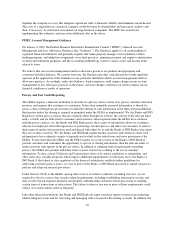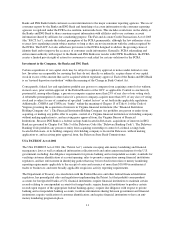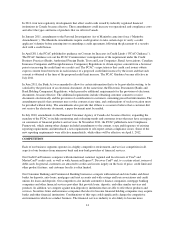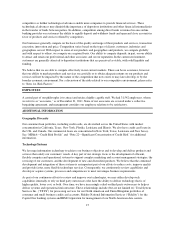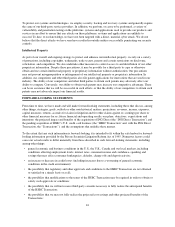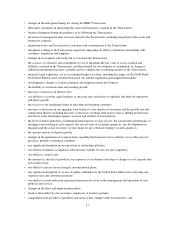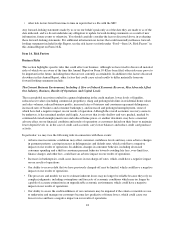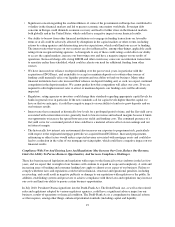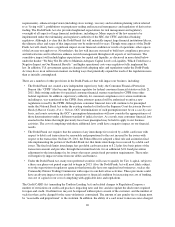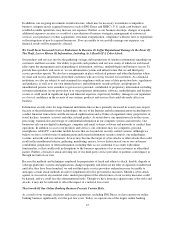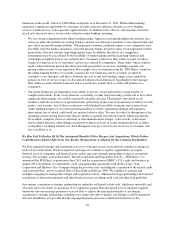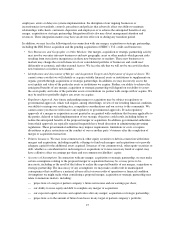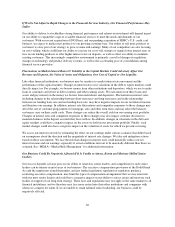Capital One 2011 Annual Report Download - page 40
Download and view the complete annual report
Please find page 40 of the 2011 Capital One annual report below. You can navigate through the pages in the report by either clicking on the pages listed below, or by using the keyword search tool below to find specific information within the annual report.requirements), enhanced supervision (including stress testing), recovery and resolution planning (often referred
to as “living wills”), prohibitions on proprietary trading and increased transparency and regulation of derivatives
trading. The Dodd-Frank Act also provides heightened expectations for risk management and regulatory
oversight of all aspects of large financial institutions, including us. Many aspects of the law remain to be
implemented under the rulemaking and regulatory authority of the SEC, the CFTC and federal banking
regulators. Although it is clear that the Dodd-Frank Act will materially impact large financial institutions like us,
the ultimate effect and scope of that impact may not be understood for years. Though some aspects of the Dodd-
Frank Act will clearly have a significant impact on our financial condition or results of operations, other aspects
of the law may not apply to us. Nevertheless, the law will increase our need to build new compliance processes
and infrastructure and to otherwise enhance our risk management throughout all aspects of our business. The
cumulative impact will include higher expectations for capital and liquidity, as discussed in more detail below
under the header “We May Not Be Able to Maintain Adequate Capital Levels or Liquidity, Which Could have a
Negative Impact on Our Financial Results,” and higher operational costs once regulators fully implement the
law. In addition, U.S. government agencies charged with adopting rules and regulations under the Dodd-Frank
Act may do so in an unforeseen manner, including ways that potentially expand the reach of the legislation more
than as initially contemplated.
There are a number of other provisions in the Dodd-Frank act that will impact our business, including:
• The Dodd-Frank Act created a new independent supervisory body, the Consumer Financial Protection
Bureau (the “CFPB”) that became the primary regulator for federal consumer financial statutes on July 21,
2011. Rule writing authority for specified consumer financial statutes transferred to CFPB from other
federal regulators. In addition, supervisory authority for consumer compliance over various institutions,
including us, was transferred to the CFPB. State attorneys general will be authorized to enforce new
regulations issued by the CFPB. Although state consumer financial laws will continue to be preempted
under the National Bank Act under the existing standard set forth in the Supreme Court decision in Barnett
Bank of Marion County, N.A. v. Nelson, OCC determinations of such preemption must be on a case-by-case
basis, and courts reviewing the OCC’s preemption determinations will now consider the appropriateness of
those determinations under a different standard of judicial review. As a result, state consumer financial laws
enacted in the future that might previously have been preempted may be held to apply to our business
activities. The cost of complying with these additional laws could have a negative impact on our financial
results.
• The Dodd-Frank Act requires that the amount of any interchange fee received by a debit card issuer with
respect to debit card transactions be reasonable and proportional to the cost incurred by the issuer with
respect to the transaction. On June 29, 2011, the Federal Reserve adopted a final rule and an interim final
rule implementing the portion of the Dodd-Frank Act that limits interchange fees received by a debit card
issuer. The final rule limits interchange fees per debit card transaction to $.21 plus five basis points of the
transaction amount and provides, through the interim final rule, for an additional $.01 fraud prevention
adjustment to the interchange fee for issuers that meet certain fraud prevention requirements. These rules
will negatively impact revenue from our debit card business.
• Under the Dodd-Frank Act, many trust preferred securities will cease to qualify for Tier 1 capital, subject to
a three year phase-out period expected to begin in 2013. Also, the Dodd-Frank Act will most likely subject
us to the supervision of regulatory agencies that historically have not regulated our businesses, such as the
Commodity Futures Trading Commission with respect to our derivatives activities. These provisions could
have an adverse impact on our results of operations or financial condition by increasing our cost of funding,
our cost of capital or our cost of complying with applicable laws and regulations.
The Credit CARD Act (amending the Truth-in-Lending Act) and related changes to Regulation Z impose a
number of restrictions on credit card practices impacting rates and fees and also update the disclosures required
for open-end credit. Overlimit fees may not be imposed without prior consent of the customer, and the number of
such fees that can be charged for the same violation is constrained. The amount of any penalty fee or charge must
be “reasonable and proportional” to the violation. In addition, the ability of a card issuer to increase rates charged
20


